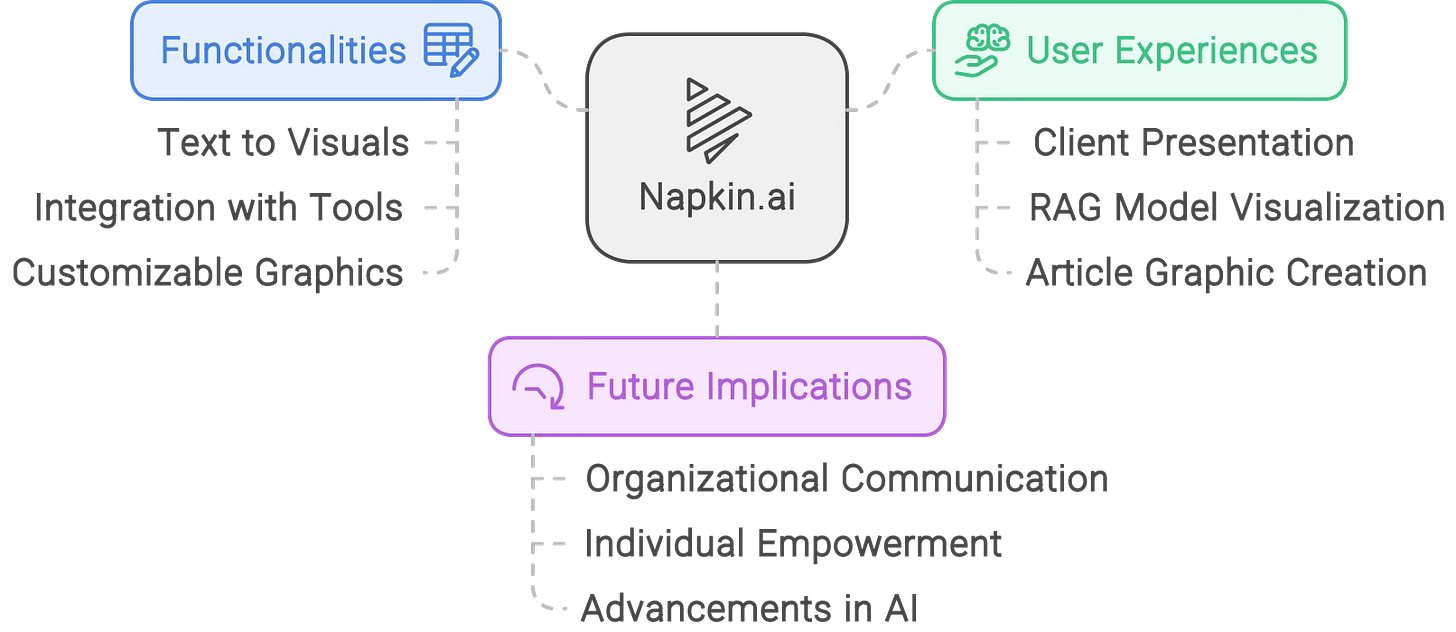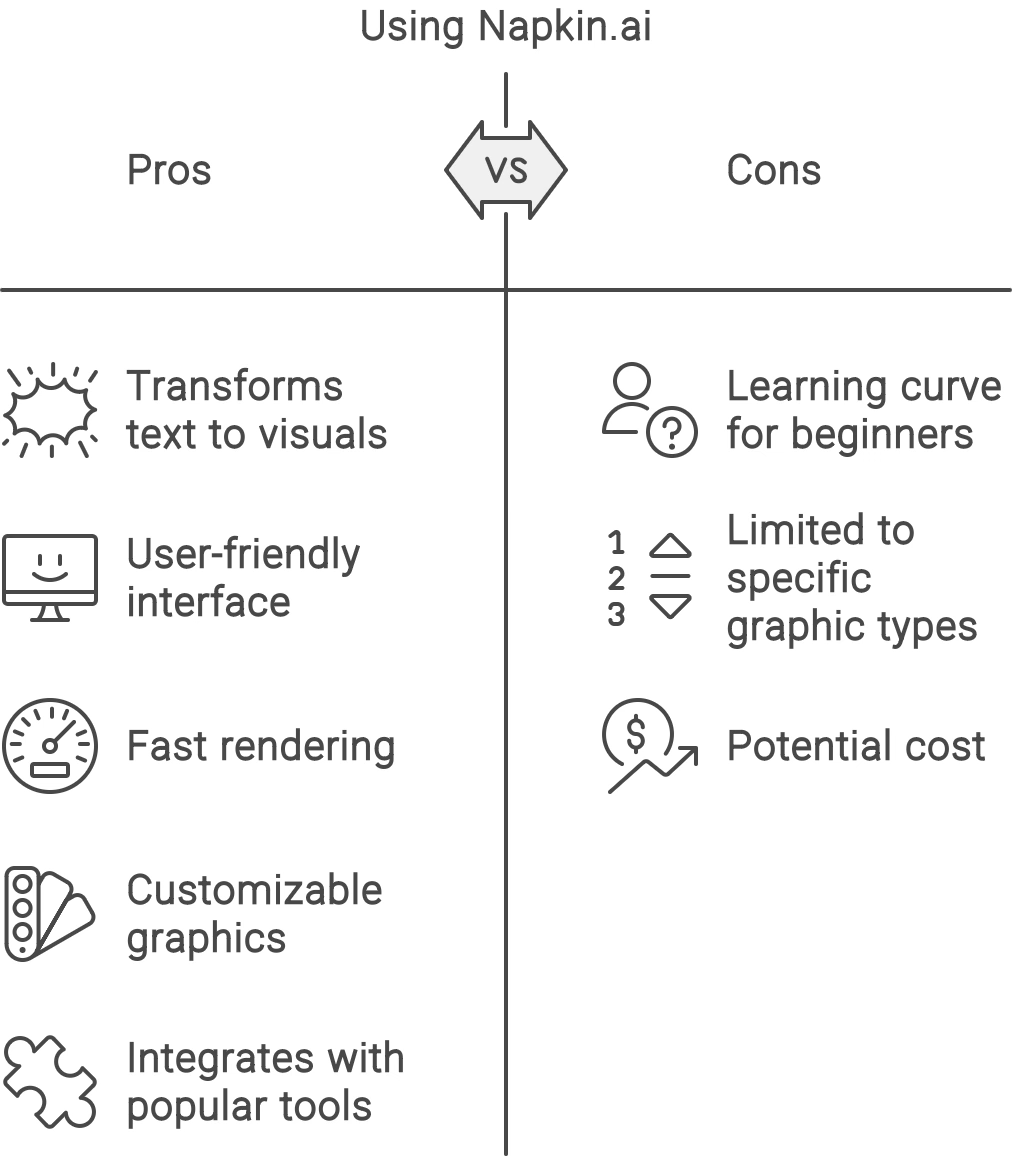Harnessing the Power of Napkin.ai for Visual Storytelling
I recently came across a fascinating tool called Napkin.ai, which has completely transformed the way I approach visual storytelling in both client presentations and internal communications. As a futurist and strategist, I'm always on the lookout for technologies that can bridge the gap between complex ideas and clear, impactful communication. Napkin.ai does precisely that—it takes text-based concepts and effortlessly turns them into compelling visuals. This tool is a game-changer for anyone looking to communicate complex ideas more effectively, and today, I want to share my experiences using it, as well as explore what this means for the future of organizations and individuals.
What is Napkin.ai?
Napkin.ai is an AI-driven platform designed to convert text into visually engaging graphics. Whether you're preparing a business presentation, developing a strategic plan, or crafting content for social media, Napkin.ai simplifies the process of creating visuals that enhance understanding and engagement. The tool offers a wide range of graphic types, from charts and diagrams to more intricate visualizations, all of which can be customized to fit your brand’s aesthetic.
One of the standout features of Napkin.ai is its user-friendly interface, which makes it accessible to both beginners and seasoned professionals. The platform's latest version, Napkin AI V3, offers faster rendering times, more complex visual generation, and expanded creative controls, making it an indispensable tool for anyone involved in business communication.
My Experience with Napkin.ai: A Client Presentation
Recently, I was preparing a presentation for a prospective client who needed to understand how a Retrieval-Augmented Generation (RAG) AI model would work within their environment. The RAG model is an advanced AI framework that enhances generative AI by incorporating real-time data retrieval, allowing the model to generate responses based on the most current and relevant information. This is particularly valuable in dynamic business environments where the accuracy and relevance of information are critical.
Explaining this concept to a non-technical audience can be challenging, especially when you want them to grasp not just the theory, but how it would function specifically within their unique operational environment. I turned to Napkin.ai to help me create a visual that would make this explanation both simple and engaging.
I started by inputting a brief description of the RAG AI model into Napkin.ai. The platform immediately generated a series of graphic options, including a flowchart that illustrated how data is retrieved in real-time, processed by the AI, and then used to generate outputs that are both accurate and contextually relevant. I was able to customize the colors, labels, and even the shapes of the nodes to better align with the prospect's brand guidelines.
During the presentation, the visual I created with Napkin.ai became the centerpiece of my explanation. It allowed the audience to see at a glance how the RAG model would enhance their decision-making processes by integrating up-to-date information into the AI's generative outputs. The clear, intuitive graphic not only helped them understand the concept but also facilitated a productive discussion about how this technology could be implemented to improve their business operations. The ability to present such a complex AI model in a way that was both accessible and visually appealing was invaluable, and I credit Napkin.ai for making that possible.
Creating the Graphics for This Article
The graphics included in this article were also created using Napkin.ai, and they serve as a perfect example of how this tool can summarize and illustrate complex ideas. To create these graphics, I started with a rough outline of the key points I wanted to convey: the functionality of Napkin.ai, the benefits it offers, and its potential impact on organizations and individuals.

Napkin.ai's AI instantly parsed my text and presented me with several layout options. I chose ones that highlighted the flow from text input to visual output, emphasizing the simplicity and power of the tool. The AI suggested adding icons to represent each stage of the process, from brainstorming and ideation to visual creation and presentation. I was able to tweak the design, selecting colors and fonts that matched the overall aesthetic of this article.
The final graphics encapsulate the core message of this piece: that Napkin.ai is a tool designed to bridge the gap between complex ideas and effective communication. They visually represent the journey from concept to clarity, showing how text-based ideas can be transformed into visuals that resonate with audiences. The process of creating these graphics was smooth and intuitive, reinforcing my belief in the value of this tool for both personal use and professional applications.
The Futurist Lens: What This Means for Organizations and Individuals
From a futurist perspective, the rise of tools like Napkin.ai represents a significant shift in how we communicate complex ideas. In a world where attention spans are dwindling and the demand for clear, concise information is growing, the ability to convert text into engaging visuals is more important than ever. This tool democratizes the process of creating high-quality visuals, making it accessible to individuals who may not have a background in design or data visualization.
For organizations, Napkin.ai offers a way to enhance communication both internally and externally. Internally, teams can use it to visualize strategic plans, project timelines, and data-driven insights, fostering a culture of transparency and collaboration. Externally, businesses can leverage Napkin.ai to create compelling presentations, proposals, and marketing materials that resonate with clients and stakeholders.
On an individual level, Napkin.ai empowers professionals to take control of their own communication. It removes the barriers to visual storytelling, allowing anyone to present their ideas in a way that is both visually appealing and easy to understand. This is particularly important in today's fast-paced, information-rich environment, where the ability to communicate effectively can be a key differentiator in one's career.
Looking ahead, I see tools like Napkin.ai becoming an integral part of the professional toolkit, much like PowerPoint or Excel. As AI continues to advance, we can expect these tools to become even more sophisticated, offering greater customization, real-time collaboration, and integration with other AI-driven platforms. The future of communication is visual, and Napkin.ai is leading the charge.
Napkin.ai is more than just a tool—it's a catalyst for better communication. Whether you're explaining a complex AI model to a client or summarizing key concepts in an article, Napkin.ai makes it easier to convey your message clearly and effectively. As we move into a future where visual communication is paramount, tools like Napkin.ai will be essential for both organizations and individuals looking to stay ahead of the curve.



